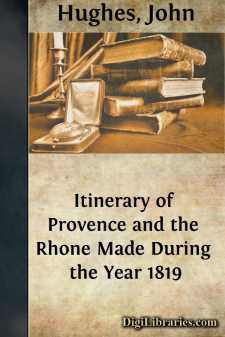Categories
- Antiques & Collectibles 13
- Architecture 36
- Art 48
- Bibles 22
- Biography & Autobiography 813
- Body, Mind & Spirit 142
- Business & Economics 28
- Children's Books 15
- Children's Fiction 12
- Computers 4
- Cooking 94
- Crafts & Hobbies 4
- Drama 346
- Education 46
- Family & Relationships 57
- Fiction 11828
- Games 19
- Gardening 17
- Health & Fitness 34
- History 1377
- House & Home 1
- Humor 147
- Juvenile Fiction 1873
- Juvenile Nonfiction 202
- Language Arts & Disciplines 88
- Law 16
- Literary Collections 686
- Literary Criticism 179
- Mathematics 13
- Medical 41
- Music 40
- Nature 179
- Non-Classifiable 1768
- Performing Arts 7
- Periodicals 1453
- Philosophy 64
- Photography 2
- Poetry 896
- Political Science 203
- Psychology 42
- Reference 154
- Religion 513
- Science 126
- Self-Help 84
- Social Science 81
- Sports & Recreation 34
- Study Aids 3
- Technology & Engineering 59
- Transportation 23
- Travel 463
- True Crime 29
Itinerary of Provence and the Rhone Made During the Year 1819
by: John Hughes
Description:
Excerpt
PARIS TO ROCHEPOT.
No one, I imagine, ever yet left an hotel in a central and bustling part of Paris, without feeling the faculty of observation strained to the utmost, and experiencing a whirl and jumble of recollections as little in unison with each other as the well known signs of that whimsical city, the Bœuf à-la-mode, (with his cachemire shawl and his ostrich feathers) and the Mort d'Henri Quartre. The contrasts and varieties of the grave and gay, the affecting and the burlesque, the magnificent and the paltry, which exist and may be sought out in abundance in every great capital, are perhaps more vividly concentrated at Paris than any where else, and brought with less trouble under the eye of those whose spirits or leisure may not allow them to mix in society. In London every thing wears a busy uniform exterior, varied only by the apparition of a Turk, a Lascar, or a Highlander; and home appears to be the place reserved for the development of character: but in Paris, from the fashion of living almost in public, and the freedom which every one enjoys of following his own taste in dress or amusement without notice, the history of most individuals appears to a certain degree written on their exterior; and a morning's walk brings you in contact with all the diversities of character which rapidly succeeding events have created. The old beau, with the identical toupet of 1770; the musty, moth-eaten nondescripts sometimes seen at the mass of Notre Dame, which remind you of a still earlier period; the faded royalist, with a countenance saddened by the recollection of former days; the ex-militaires, whose looks own no friendship with "the world or the world's law;" the old bourgeois riding in the same roundabout with his grandchildren, and enjoying the jeu de bague as cordially,—revolve in succession like the different figures in a magic lantern, while the place of Punch and Pierrot is supplied by a host of laborious drolls and gens à l'incroyable. The various members of this motley assemblage appear also more distinct from each other, as connected in the recollection with places so strongly marked by historical events, or bearing in themselves so peculiar a character:—the place Louis Quinze, the grim old Conciergerie, the deserted Fauxbourg St. Germain, with the grass growing in its streets; the Place de Carousel, the Boulevards, and the Catacombs, the Palais Royal and the Morgue.
To attempt, however, to say any thing new of a place so well known and so fully described as Paris, would be as superfluous as to write the natural history of the dog or cat. The peculiarities of such animals are continually striking one in new and amusing points of view; but verbal delineation has already done its utmost in acquainting us with them. In like manner, every thing relating to Paris, and illustrative of it at a period of interest which probably will not arise again for centuries, has been already made known in Paul's admirable letters, in poor Scott's powerful but unmerciful satire, and finally in a host of books, booklings, and bookatees, teaching us how to spend any period of time at Paris from three to three hundred and sixty-five days; how to enjoy it, how to eat, drink, see, hear, feel, think, and economise in it....


